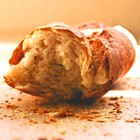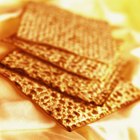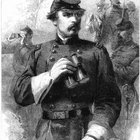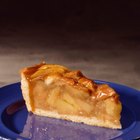
A biscuit cutter is a kitchen tool used to cut biscuit dough into even shapes. A biscuit cutter is similar to a cookie cutter, except that you use it to cut biscuit dough instead of cookie dough. The biscuit cutter was invented in 1875 by Alexander P. Ashbourne, an African-American inventor and dry goods grocer from Oakland, California.
Function
Biscuit cutters can be made out of both metal and plastic. They are generally round. Their sides can be either straight or fluted. The purpose of the biscuit cutter is to ensure that each biscuit from a batch is the same size. This helps ensure that the biscuits will cook evenly. If biscuits are different sizes, they may cook at different rates, resulting in a batch where some biscuits are overcooked and some are overdone. Some biscuit cutters come in decorative shapes, like hearts or stars. To prevent biscuit dough from sticking to the sides of your biscuit cutter, dip it in flour before you cut.
History
The biscuit dates back to Roman times. Its name means "twice-cooked" in Latin. The American biscuit is different from the British biscuit -- in Britain, "biscuit" means a cracker or cookie, while in America, a biscuit is a quick bread made using either yeast, baking soda or baking powder. The American biscuit emerged in the 1800s and was especially popular in the South. Cooks would mix their biscuits and then roll and shape them by hand. In 1875, Alexander P. Ashbourne patented the first biscuit cutter. It consisted of a board to roll the biscuits out on, which was hinged to a metal plate with various biscuit cutter shapes mounted to it. After you rolled the biscuits out, you brought the plate down on the dough, creating many biscuit shapes at once. The cutters were spring-loaded, allowing the biscuit shapes to be easily released. The biscuit cutter also came with a space to store your rolling pin.
Today, biscuit cutters are much simpler -- perhaps because biscuits are less common, and we make them in smaller quantities.
Significance
After the Civil War, many African-Americans entrepreneurs entered the food industry. Emancipation meant that African-Americans could move to different regions, pursue higher education, and start businesses. Many African-Americans started catering businesses or became grocers. They also created many food-related inventions. Besides Ashbourne's biscuit cutter, African-American inventors of the 1870s, 1880s, and 1890s also patented bread-making machines, the ice-cream scoop, dough-kneaders, lemon-squeezers, the lunch pail, the refrigerator, the corn silker and the egg beater.
Substitutes
Cookie cutters are a good substitute for a biscuit cutter, although it's important to use the simplest cookie cutter shapes possible. You can cut biscuits into detailed shapes, but that detail will be lost once the biscuits have cooked. This is because biscuits rise so much during baking. Empty, clean tomato paste cans can also be used. These will result in small, round biscuits.
Ashbourne's Other Inventions
In addition to inventing the biscuit cutter, Ashbourne also patented processes for treating and refining coconut oil.
Related Articles
Can I Store Biscuit Dough Overnight?

What Is Indian Flat Bread Called?

How to Make Egyptian Bread the Egyptian ...

What Is Docking Used for in Baking?

Different Breads From Different ...

What Is the Difference Between a Bagel ...

Can You Freeze Leftover Dough From a ...

About Colonial Desserts

Can You Bake Doughnuts Without the ...

Differences Between French & Italian ...

How to Substitute Margarine for Butter ...

Where to Buy Phyllo Dough

What Is the Difference Between Scones & ...

What Is Unleavened Bread?

What Are Rusk Crumbs?

The History of Pop-Up Toasters

Men's Roles in the 1800s
Why Are My Biscuits Always Flat?

How to Freeze Unbaked Pies

Can I Bake Cupcakes in Teacups?
References
Resources
Writer Bio
Emily Maggrett has been writing for more than eight years. Her fiction has appeared in "Jeopardy" and "Rivet" and her journalism has appeared in "The Cascadia Weekly" and "The Western Front." Maggrett holds a Bachelor of Arts in English literature from Western Washington University.
Photo Credits
Denzil Green